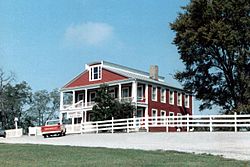Crenshaw House (Gallatin County, Illinois) facts for kids
The Crenshaw House (also known as the Crenshaw Mansion or Hickory Hill) is a historic home in Equality Township, Illinois. It was built in the 1830s. This large house was the main home for John Crenshaw, his wife, and their five children.
In 2004, the National Park Service recognized the mansion as a "station" on the Reverse Underground Railroad. This was because John Crenshaw was known for kidnapping free Black people in Illinois and selling them into slavery in other states.
Quick facts for kids |
|
|
Crenshaw House
|
|

Front and side of the house
|
|
| Location | Off Rt. 1, Equality, Illinois |
|---|---|
| Area | 2 acres (0.81 ha) |
| Built | 1834 |
| Architect | William Gavin |
| Architectural style | Greek Revival architecture, Vernacular Greek Revival |
| NRHP reference No. | 85001164 |
| Added to NRHP | May 29, 1985 |
Contents
The Crenshaw House: A Historic Home
The Crenshaw House is a large, old building with a long history. It is sometimes called "The Old Slave House" because of its connection to slavery. The house is located in Gallatin County, Illinois, near the town of Equality, Illinois. It was built in 1834.
Who Was John Crenshaw?

John Hart Crenshaw was a very wealthy landowner. He leased state-owned salt works near Equality, Illinois. These salt works were important because salt was needed to preserve food and was valuable in the early days of America.
Even though Illinois was a free state where slavery was not allowed, the law made an exception for the salt works. This was because the work was so difficult that few free people would do it. As the person leasing the salt works, Crenshaw was one of the few people in Illinois legally allowed to have enslaved people.
Crenshaw became very rich from the salt business. He owned thousands of acres of land. He also had more than 700 enslaved people working for him. In 1838, Crenshaw and his brother built the large mansion on Hickory Hill. It was a few miles from the salt works.
A Visit from Abraham Lincoln
In September 1840, Abraham Lincoln visited Gallatin County. He was a state representative at the time. Lincoln attended debates in Old Shawneetown, Illinois and Equality.
The Crenshaws hosted a big party, called a ball, in honor of the debates. This party was held on the second floor of the house. The second floor was designed to be easily turned into a ballroom. It had movable walls for such events.
Mr. Lincoln and other male guests stayed overnight in a bedroom on the second floor. The room had one bed and two chairs. Lincoln was very tall, so he might have slept on the floor or across the chairs.
The House Today
In 1850, Crenshaw and his family moved to the town of Equality. They hired a German family to live in the house and manage the farm. Crenshaw sold the house in 1864. He passed away in 1871 and was buried nearby.
By 1913, the Sisk family owned the house. They started offering public tours. They told visitors it would be "a thrilling experience."
In 1996, George Sisk, Jr. retired and closed the museum. In December 2000, the Sisk family sold the house to the state of Illinois. The state paid $500,000 for the house and 10 acres of land.
The Crenshaw House is currently closed to the public. The state is deciding what to do with it. To open it again, the house would need many repairs and renovations. It would also need a new road, parking lot, and a separate building with bathrooms. These changes are expected to be very expensive.
Images for kids
-
The Saline River in southeastern Illinois. Here, John Crenshaw leased out enslaved people who boiled salt water from the river to make salt.
-
A picture from 1834 showing the kidnapping of a free Black person to be sold into slavery. John Crenshaw was involved in such actions.





